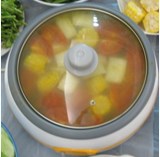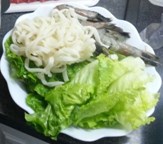Strategies for Enjoying a Healthy Hot Pot Meal
In cooler seasons, many local restaurants sell hot pot meals in a buffet setting. Classic hot pot meals include a pork-bone soup base, fatty beef cuts and meatballs, all of which are ‘musts’ for most hot pot customers. Yet, these food items are high in energy and fat. In a buoyant mood, people tend to overeat, yielding to a large intake of fat and energy. In fact, hot pot eating could still be part of our healthy diet as long as we smartly choose the soup base and ingredients.

Soup base
Pork-bone soup base and extra spicy hot soup base are particularly rich in grease. What’s more, meat releases grease when blanched, adding to the fat content of the soup base. Excessive intake of fat increases the risk of obesity, and the saturated fat in meat is even harmful for cardiovascular health.
- Suggestion: Avoid drinking the soup base in which meat has been blanched. Choose a soup base of preserved duck egg/coriander, tomato/potato, or soya milk, to reduce fat intake.
Choice of ingredients

Increase the portion of vegetables and grains
According to the principles of healthy diet, our diet should include a generous portion of grains and vegetables. However, most people go for fatty and processed meats like fatty beef cuts, mutton, fish dumplings, squid balls and sausages when ordering items for a hot pot meal, thereby increasing fat and sodium intake.
- Suggestion: When ordering hot pot food items, think about the points below:
- Include in your order a selection of vegetables (including carrots/turnips) and mushrooms/fungi (e.g. bamboo fungus); eat a larger portion of vegetables and a smaller portion of meat.
- Include grain products like udon noodles, rice noodles, shirataki (konjac) noodles, etc., for better satiety. This helps to avoid excessive hunger and intake of meat.
- For meat, choose lean meat like fresh fish slices, seafood, beef shank, skinned and boned chicken. The portion of meat for each person should not exceed three to four taels (i.e. the size of three to four table tennis balls), while it may include an extra meat portion which is otherwise set for lunch.
Cut down on the use of seasonings
When people have hot pot meals, it is a popular practice for them to dip the food in high-sodium seasonings such as sacha sauce or satay sauce. Prolonged excessive intake of sodium increases the risk of hypertension.
- Suggestion: Cut down on the use of seasonings whenever possible. If your food is too bland in taste, prepare a dip with soy sauce mixed with shallot, ginger, garlic or chilli for seasoning.
Cut down on sugary drinks

When eating hot pot food, local people also drink sugary drinks such as soft drinks, sour-plum drink, sugar cane juice, and “sugar cane and cogongrass root” drink as a customary practice. However, excessive consumption of sugary drinks is not recommended as this increases energy and sugar intakes, which may cause weight gain.
- Suggestion: Drink water or sugar-free tea instead. If you prepare sour-plum drink, sugar cane juice or “sugar cane and cogongrass root” drink at home, keep track of the sugar added.
Since the soup base, viscera and shellfishes (e.g. scallops, oysters, mussels) all contain a considerable level of purines, gout patients should pay attention and restrict the intake of these foods so as to avoid worsening of their own conditions.
To know more about …
- healthy eating, please visit ‘Health Zone’ website at http://www.cheu.gov.hk
- ‘Health@work.hk Project’, please visit http://www.healthatwork.gov.hk
 Top
Top



